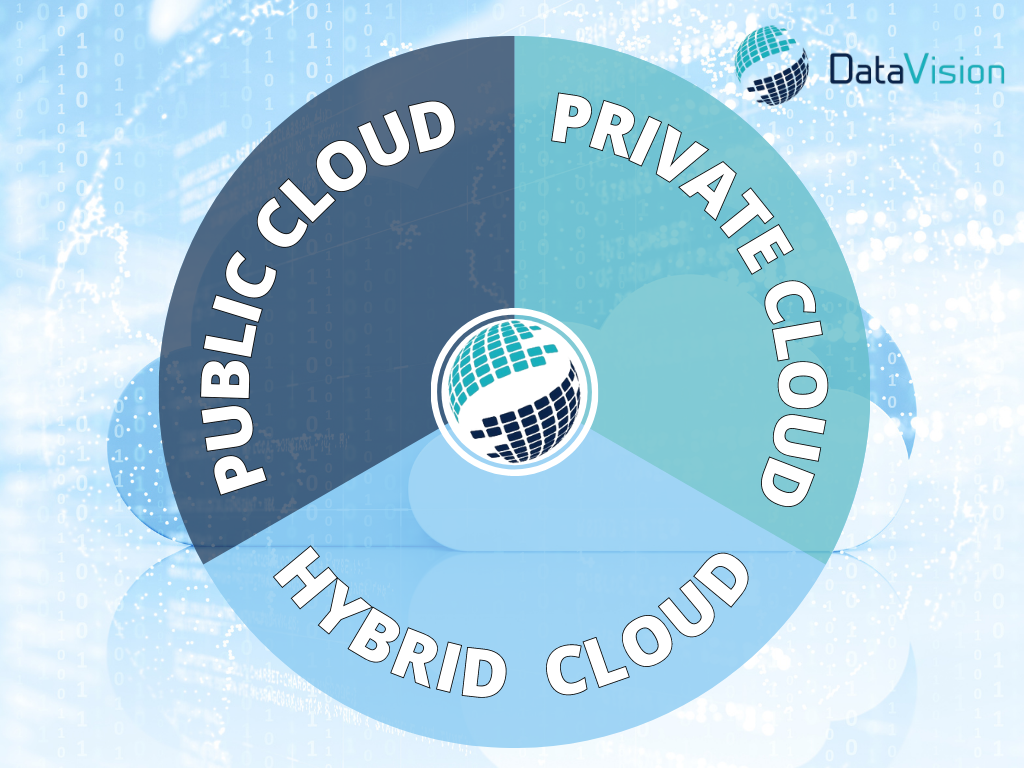DataVision was founded in 1992 with the purpose of providing clients with customisable, scalable and affordable banking software products and solutions.
Uchil Heights, Jagdishnagar, Raj Bhavan Road, Aundh, Pune - 411007, Maharashtra, India
+91-20-25690661/2/3
info@datavsn.com

The difference between Public, Private, and Hybrid Cloud in banking
The banking business has been significantly impacted by the rapid development of technology, which has led to a shift towards digitalization and cloud computing. Banks must select between public, private, and hybrid cloud solutions to fulfil their specific needs in light of the growing importance of scalability, security, and cost-efficiency.
Third-party service providers own and operate public clouds, which are accessible via the Internet and offer cost savings and scalability. On the other hand, private clouds are exclusive to a particular business and offer complete security and privacy control.
Hybrid clouds include both public and private clouds, providing banks with both advantages. From the perspective of banking, we will examine the distinctions between public, private, and hybrid cloud systems and the benefits and drawbacks of each.
In addition, we will investigate how banks might utilize these cloud technologies to satisfy their unique requirements and improve customer service.

Public Cloud
Public cloud computing is a cloud infrastructure available to the public and managed by third-party cloud service providers. Public cloud services suit non-critical tasks like hosting emails, managing documents, and working together. This helps banks lower their IT infrastructure costs. Public cloud providers offer pay-as-you-go pricing, allowing banks to pay only for the facilities they use. Public cloud computing provides banks with flexibility and scalability to meet changing business requirements.
Let’s review the advantages and disadvantages of the Public Cloud:
Advantages:
Cost Savings: Public clouds offer pay-as-you-go pricing models, enabling banks to pay only for the resources they use. Public clouds are more cost-effective for non-critical operations, such as email hosting and document management.
Scalability: Public clouds offer high scalability, allowing banks to scale their infrastructure up or down based on their business requirements.
Flexibility: Public clouds allow banks to access their data and applications from anywhere, making it easier for employees to work remotely.
Disadvantages:
Security Concerns: Public clouds may pose security risks as multiple organizations use them. Banks must ensure that their cloud service provider meets regulatory requirements and provides adequate security measures.
Compliance: Public clouds may need to meet regulatory compliance requirements, making them unsuitable for certain operations.
Downtime: Public clouds may experience outages, leading to system downtime and lost productivity.
Private Cloud
Private cloud computing is an entire cloud infrastructure that is either hosted on-premises or off-premises. Banks prefer private clouds because they offer complete control, high security, and compliance. They enable banks to manage their infrastructure, applications, and data while ensuring the security of their assets. Private cloud computing provides banks with the customization they need to comply with regulatory requirements and protect their customers’ data.
Now, let’s consider the benefits and drawbacks of the Private Cloud.
Advantages:
Complete Control: Private clouds provide banks with complete control over their infrastructure, applications, and data. Banks can customize their private cloud to meet their specific business requirements and comply with regulatory requirements.
High Security: Private clouds offer high levels of security as a single organization exclusively uses them. Banks can control access to their private cloud and ensure unauthorized users do not access sensitive data.
Compliance: Private clouds enable banks to comply with regulatory requirements as they provide complete control over the infrastructure and data.
Disadvantages:
High Costs: Private clouds require significant investments in infrastructure and resources, making them more expensive than public clouds.
Limited Scalability: Private clouds have limited scalability compared to public clouds, which can be challenging to manage for banks experiencing rapid growth.
Maintenance and Management: Private clouds require specialized IT expertise, making them challenging to manage and maintain.
Hybrid Cloud
Hybrid cloud computing is a combination of private and public cloud infrastructures. It allows banks to leverage the benefits of both private and public clouds. Banks can manage their sensitive data and applications on a private cloud while using a public cloud for non-critical operations. Hybrid cloud computing allows banks to balance the need for security and compliance with the cost savings and flexibility of public cloud services.
Advantages:
Security: Hybrid clouds allow banks to keep sensitive data and applications on their private cloud while using a public cloud for non-critical operations. It provides banks with the security they need to protect their sensitive data while benefiting from public clouds’ cost savings and flexibility.
Flexibility: Hybrid clouds offer banks the flexibility to use the most appropriate cloud-computing model for their business requirements. Banks can leverage the advantages of both private and public clouds to meet their specific needs.
Scalability: Hybrid clouds provide banks with high scalability, enabling them to meet changing business requirements quickly.
Disadvantages:
Complexity: Hybrid clouds are more complex to manage than private or public clouds, requiring expertise in both cloud computing models.
Cost: Hybrid clouds may be more expensive than private or public clouds due to the additional infrastructure and resources required.
Maintenance and Management: Hybrid clouds require specialized IT expertise, making them challenging to manage and maintain.
The banking industry’s choice of cloud computing model depends on the bank’s business requirements, regulatory compliance, and security concerns. Banks must carefully assess the risks associated with cloud computing, such as data privacy, security, and regulatory compliance. They must ensure that their cloud service provider meets regulatory requirements and provides the necessary security measures. Banks must also have a disaster recovery plan to ensure the business continues despite a system outage.
One of the substantial advantages of cloud computing for banks is cost savings. Banks can reduce IT infrastructure costs by using public cloud services for non-critical operations, such as email hosting and document management. Cloud computing also allows banks to scale their infrastructure up or down based on their business requirements, enabling them to respond quickly to market changes.
Another advantage of cloud computing in banking is improved customer experience. Cloud computing enables banks to provide customers with a seamless and personalized experience across multiple channels such as mobile, online, and in-branch banking. Banks can leverage cloud computing to offer innovative services, such as digital wallets, mobile payments, and online loan applications, which enhance customer experience and engagement.
However, banks must carefully evaluate the risks associated with cloud computing. Data privacy and security are top concerns, and banks must ensure that their cloud service provider meets regulatory requirements and provides the necessary security measures. Banks must also have a disaster recovery plan to ensure the business continues during a system breakdown.
Conclusion
In the context of banking, the choice between public, private, and hybrid clouds is not an easy one. Each cloud solution has its advantages and disadvantages, and the best option will rely on the bank’s particular requirements and goals. However, by harnessing the benefits of both public and private clouds, banks can ensure they have the necessary resources to satisfy customers’ needs and the quickly expanding digital market. By assessing the benefits and drawbacks of each type of cloud solution, banks can make an informed decision that matches their specific needs and improves customer service.
How Can Datavision help?
Datavision stands proudly as a prominent banking software solutions provider, recognized for our unwavering commitment to excellence in the industry. We have earned our esteemed reputation by consistently delivering cutting-edge core banking software, catering to the needs of both retail and corporate banking software sectors. At Datavision, our mission is clear: to provide our clients with the best banking software products, ensuring that they stay ahead in an ever-evolving financial landscape. We take pride in serving our prestigious clients and look forward to continuing our journey of innovation and excellence.
Our portfolio of banking software product and services include:
Core Banking Solutions: | FinNext Core | Banking: | FinTrade | EasyLoan | MicroFin |
Digital Banking Solutions: | IBanc | MobiBanc | MBranch | FinTab | FinSight |
Risk & Compliance: |FinTrust |
Want to know how our team of experts at Datavision provides customizable, scalable, and cost-effective banking software products and solutions to our esteemed clients? Visit us for more information.
 Ensuring Compliance in Financial Software Development
March 31, 2025
Ensuring Compliance in Financial Software Development
March 31, 2025
 The Role of Microservices in Modernizing Core Banking Systems
March 19, 2025
The Role of Microservices in Modernizing Core Banking Systems
March 19, 2025
 How Blockchain is Impacting the Future of Banking
March 3, 2025
How Blockchain is Impacting the Future of Banking
March 3, 2025
 Data Privacy in Financial Services: Best Practices and Strategies
February 14, 2025
Data Privacy in Financial Services: Best Practices and Strategies
February 14, 2025
 Improving Trade Finance Operations through Technology
January 30, 2025
Improving Trade Finance Operations through Technology
January 30, 2025
 The Future of Mobile Banking: Trends and Predictions
January 16, 2025
The Future of Mobile Banking: Trends and Predictions
January 16, 2025
 A Guide to Effective API Management in Financial Services
December 31, 2024
A Guide to Effective API Management in Financial Services
December 31, 2024
 Top Challenges in Developing Secure Fintech Applications
December 16, 2024
Top Challenges in Developing Secure Fintech Applications
December 16, 2024
 Best Practices for Implementing EFT Switch Solutions
November 30, 2024
Best Practices for Implementing EFT Switch Solutions
November 30, 2024
 Exploring the Benefits of DevOps in Financial Software Development
November 14, 2024
Exploring the Benefits of DevOps in Financial Software Development
November 14, 2024